BMC Software Bundle
How Did BMC Software Become an IT Powerhouse?
From its humble beginnings in 1980, BMC Software has transformed from a software consulting firm into a global leader in IT management. This BMC history showcases a remarkable journey of innovation and adaptation within the ever-changing enterprise software landscape. Discover how this BMC company has continuously evolved to meet the needs of businesses worldwide.
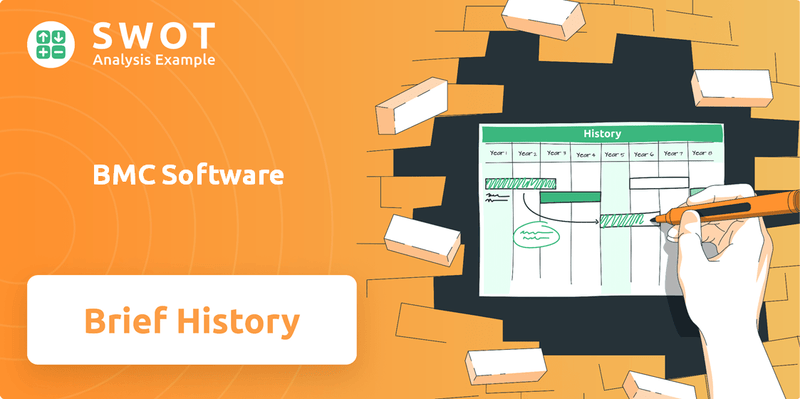
This exploration of the BMC Software company will reveal the key milestones, challenges, and strategic decisions that have shaped its trajectory. Understanding the BMC history provides valuable insights for anyone interested in the evolution of IT management and the strategies that drive success in the software company industry. From its early focus on mainframe management to its current position, this deep dive into BMC Software offers a comprehensive overview of its journey.
What is the BMC Software Founding Story?
The story of the BMC Software company began in September 1980 in Houston, Texas. It was founded by Scott Boulette, John J. Moores, and Dan Cloer. These founders, all formerly employed by Shell Oil, laid the groundwork for what would become a significant player in the IT industry.
The company's name, BMC, was derived from the founders' last initials. John Moores, at the age of 36, took on the role of the first CEO, guiding the company through its early stages of growth and development. Initially, BMC started as a software consulting firm, quickly recognizing the burgeoning demand for IT management solutions.
BMC shifted its focus to developing proprietary software products. Their initial business model centered on enhancing the efficiency of IBM mainframe computer systems, which were the industry standard at the time. In 1985, BMC released its first product, SQL-DBA, a database management system, marking its official entry into the software development industry. While specific details about the initial funding are not widely available, the company's rapid expansion and early successes suggest a strong foundation and effective management from the start.
BMC Software's journey involved a shift from consulting to proprietary software development, focusing initially on IBM mainframe systems. The company's first product, SQL-DBA, was released in 1985. BMC has grown significantly through strategic acquisitions and innovations in IT management and enterprise software.
- 1980: BMC Software is founded in Houston, Texas.
- 1985: SQL-DBA, BMC's first software product, is released.
- Early Focus: Enhancing IBM mainframe computer systems.
- Ongoing: Continuous innovation in IT management and enterprise software.
BMC Software SWOT Analysis
- Complete SWOT Breakdown
- Fully Customizable
- Editable in Excel & Word
- Professional Formatting
- Investor-Ready Format
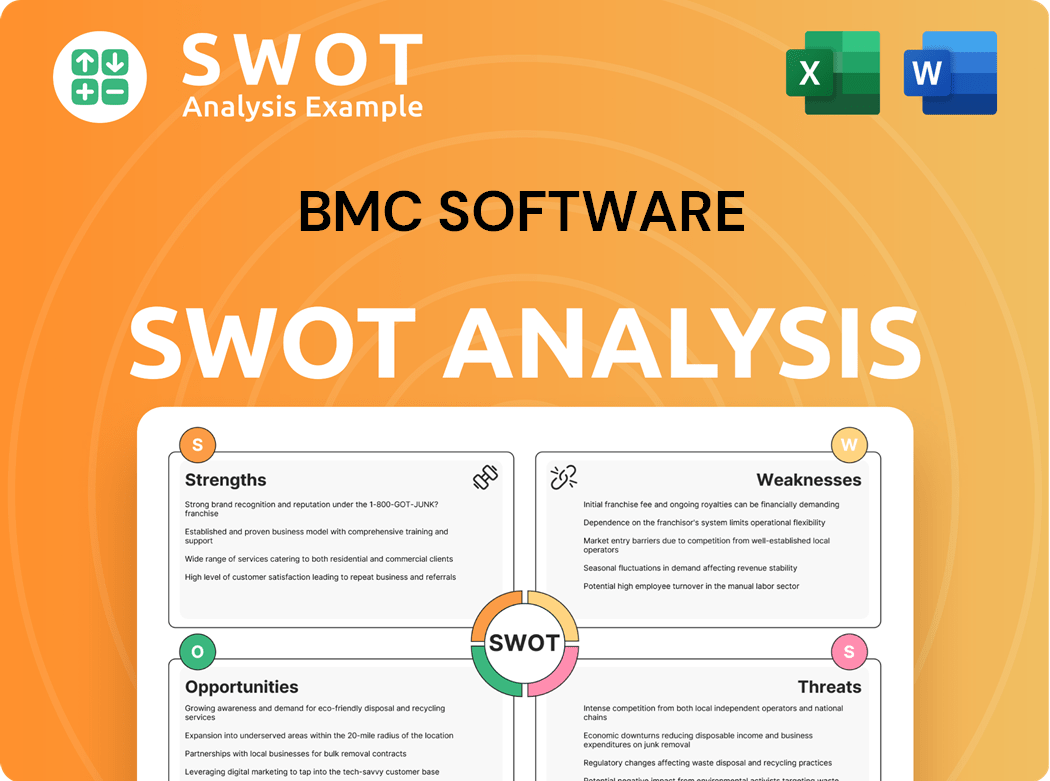
What Drove the Early Growth of BMC Software?
The early years of BMC Software were marked by rapid expansion and strategic product development. The BMC history showcases a trajectory from a startup to a significant player in the IT sector. This period laid the foundation for its future growth and influence as a leading software company.
In 1981, just a year after its founding, BMC Software achieved over $1 million in annual sales. This early success highlighted the company's potential in the market. Recognizing the need for international presence, the company opened its first international office in Frankfurt, Germany, in 1984.
Significant product launches shaped the BMC company's offerings. The SQL-DBA database management system was introduced in 1985. The launch of Control-M in 1990, a workload automation solution, was particularly transformative for IT operations. The company also began licensing its products to major clients around 1996, including Intel Corporation and Hewlett-Packard.
Leadership transitions occurred with Richard A. Hosley II succeeding John Moores as CEO in October 1987, and Max Watson Jr. taking over in April 1990. The BMC Software initial public offering (IPO) on the NASDAQ in July 1988, with trading starting on August 12, 1988, was a pivotal moment. This move further solidified the company's position in the market.
Strategic acquisitions helped expand BMC Software's capabilities. Acquisitions included Trimar Software Systems Ltd. and Trimar Software International Ltd. in January 1989 for $4.5 million, and Integrity Solutions, Inc. in 1990. By mid-1991, the company was recognized as one of the fastest-growing firms in the software field. By 2002, BMC's total revenues reached $1.3 billion.
To learn more about the company's core values, consider reading about the Mission, Vision & Core Values of BMC Software.
BMC Software PESTLE Analysis
- Covers All 6 PESTLE Categories
- No Research Needed – Save Hours of Work
- Built by Experts, Trusted by Consultants
- Instant Download, Ready to Use
- 100% Editable, Fully Customizable
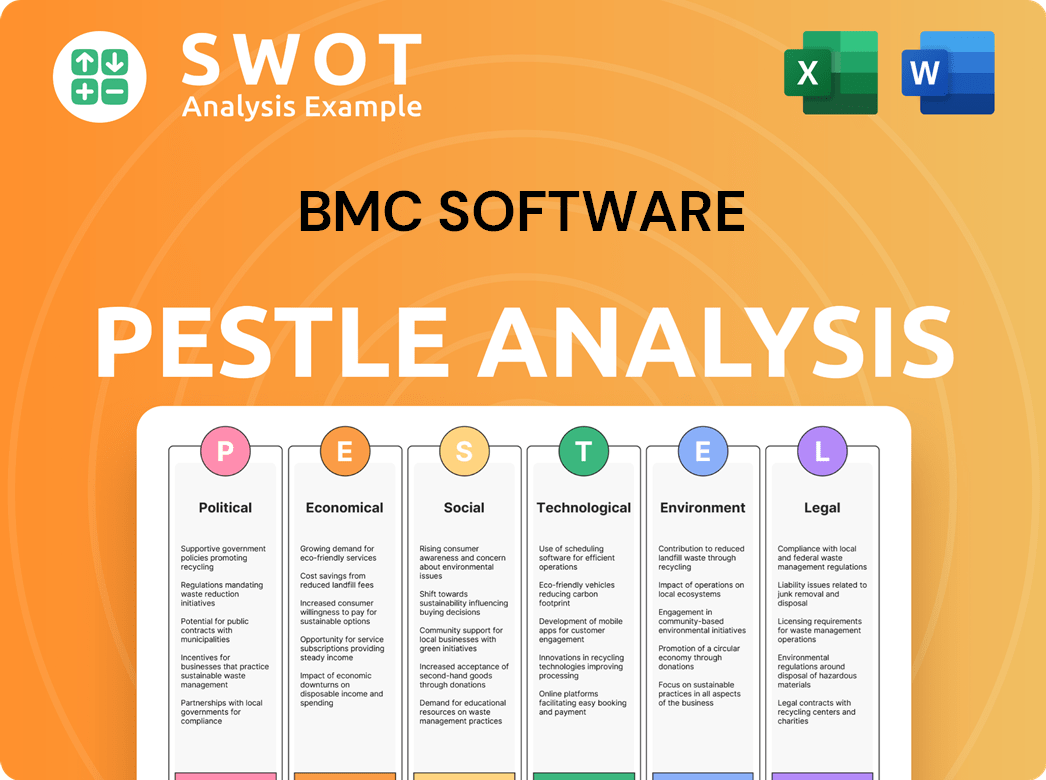
What are the key Milestones in BMC Software history?
The BMC Software company has a rich history marked by significant milestones in the IT industry. From its early days to its current position, BMC has consistently adapted and innovated to meet the evolving demands of the enterprise software market. This journey includes technological breakthroughs, strategic acquisitions, and a focus on customer needs.
| Year | Milestone |
|---|---|
| 1990 | Introduced Control-M, a workload automation solution that transformed IT operations management. |
| 1994 | Went public, solidifying its presence in the market. |
| 2002 | Acquired Remedy Software for $355 million, enhancing its cloud management and IT service management offerings. |
| 2024 | Announced its decision to split into two independent companies, BMC and BMC Helix, effective in early 2025. |
| 2025 | Released significant updates to its BMC AMI portfolio, including AI productivity enhancements and Cloud Data Sets (CDS). |
BMC Software has consistently been at the forefront of innovation in the IT sector. The company's focus on AI-driven solutions for IT operations and service management has led to advancements in automation and efficiency. These innovations support the company's goal to provide cutting-edge solutions for its customers.
The introduction of Control-M in 1990 was a groundbreaking innovation, revolutionizing workload automation. This solution significantly improved IT operations management, setting a new standard in the industry.
The acquisition of Remedy Software in 2002 for $355 million expanded the company's capabilities. This strategic move enhanced its offerings in cloud management and IT service management, strengthening its market position.
Recent years have seen a strong emphasis on AI-driven solutions, particularly in IT operations and service management. These solutions include the BMC AMI Assistant, powered by generative AI, and BMC Helix Operations Management with AIOps, enhancing IT service performance.
In January 2025, BMC released significant updates to its BMC AMI portfolio. These updates included AI productivity enhancements and Cloud Data Sets (CDS), streamlining mainframe data management.
BMC Helix Operations Management with AIOps leverages AI/ML capabilities for enhanced IT service performance. This innovation helps to improve efficiency and reduce downtime.
The BMC AMI Assistant, powered by generative AI, now supports a wide range of programming languages. This enhances developer efficiency for mainframe applications, making it easier to manage and update these systems.
Despite its achievements, BMC Software has faced challenges. The intense competition in the IT market and the increasing demand for cloud-based solutions have required significant investment in research and development. Addressing these challenges has been crucial for the company's continued success.
Intense competition within the IT industry has always been a significant challenge for BMC Software. This requires continuous innovation and strategic adaptation to maintain a competitive edge.
The growing demand for cloud-based solutions has necessitated significant investment in research and development. This shift requires BMC to adapt its offerings to meet evolving customer needs.
To address evolving market needs and accelerate growth, BMC announced a split into two independent companies. This strategic pivot is designed to allow each entity to innovate more quickly and address specific market demands.
In October 2024, BMC announced its decision to split into two independent companies, BMC and BMC Helix, effective in early 2025. This strategic move aims to allow each entity to innovate more quickly and address specific market demands.
BMC will continue to focus on Intelligent Z Optimization and Transformation (IZOT) and Digital Business Automation (DBA). This strategic focus ensures that the company stays at the forefront of innovation in these key areas.
BMC Helix will specialize in Digital Service and Operations Management (DSOM) with an AI-driven approach. This focus allows for specialized innovation in this crucial sector.
The strategic decisions and innovations of BMC Software, as detailed in the Growth Strategy of BMC Software, reflect its adaptability and commitment to the future of IT management. The company continues to evolve and adapt to meet the changing needs of its customers.
BMC Software Business Model Canvas
- Complete 9-Block Business Model Canvas
- Effortlessly Communicate Your Business Strategy
- Investor-Ready BMC Format
- 100% Editable and Customizable
- Clear and Structured Layout
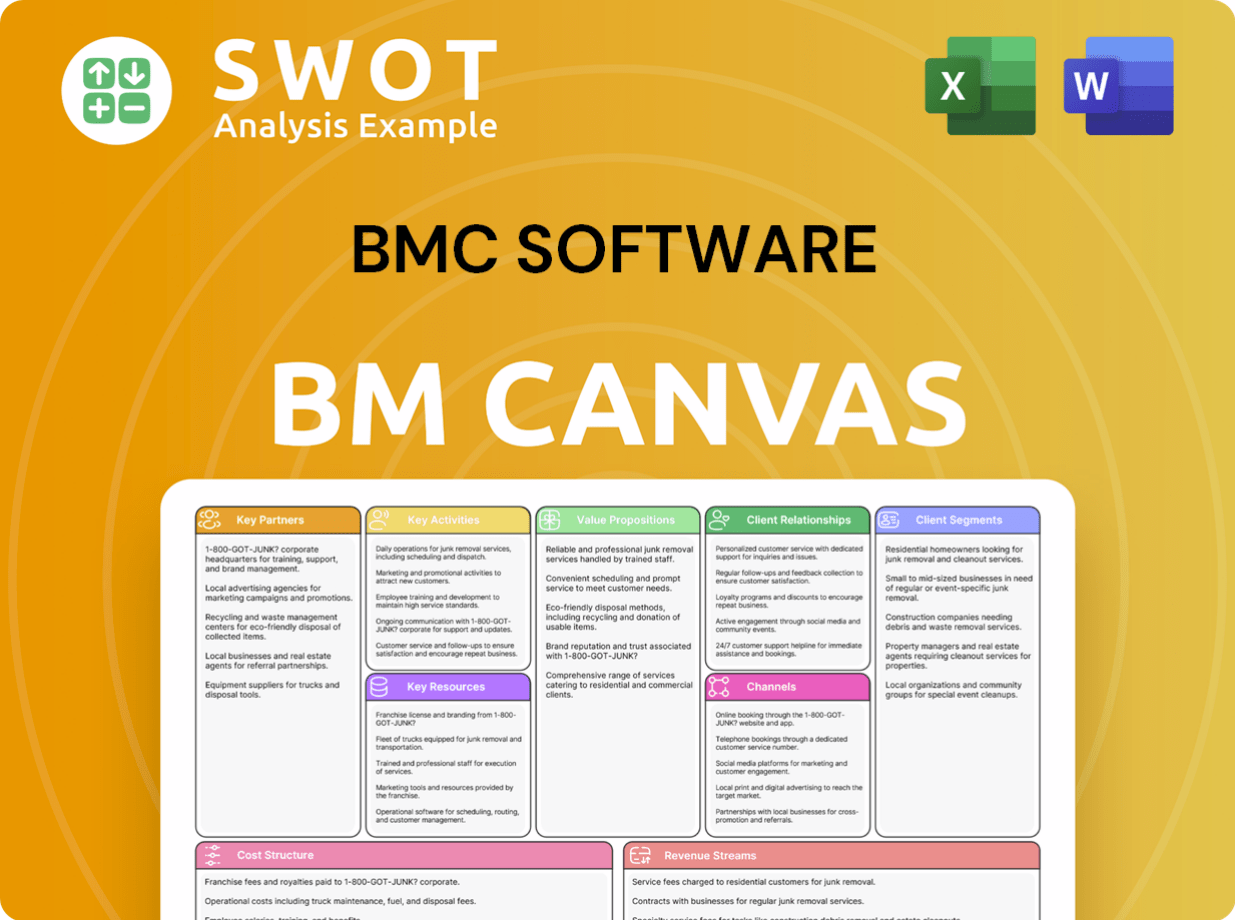
What is the Timeline of Key Events for BMC Software?
The journey of BMC Software, a prominent software company, began in 1980 with its founding in Houston, Texas. The company has evolved significantly since then, marked by strategic acquisitions, technological advancements, and shifts in ownership. The timeline reflects its growth from a startup to a global enterprise, adapting to the changing landscape of IT management and enterprise software.
| Year | Key Event |
|---|---|
| 1980 | BMC Software is founded in Houston, Texas. |
| 1981 | The company records over $1 million in annual sales. |
| 1984 | The first international office opens in Frankfurt, Germany. |
| 1985 | The company releases its first product, SQL-DBA. |
| 1988 | BMC goes public with an initial public offering on the NASDAQ. |
| 1990 | Introduces Control-M, its flagship workload automation solution. |
| 1993 | Relocates to a new complex in Houston's Westchase area. |
| 1994 | Acquires Patrol Software for $33 million. |
| 2002 | Acquires Remedy Software for $355 million. |
| 2013 | Acquired by a private investor group for $6.9 billion. |
| 2018 | Acquired by KKR for $10 billion. |
| 2020 | Acquires Compuware. |
| 2023 | Acquires Model9 and rebrands its software as AMI Cloud. |
| October 2024 | Announces the creation of two independent companies: BMC and BMC Helix, effective early 2025. |
| January 2025 | Releases January 2025 update to BMC AMI portfolio, including AI productivity enhancements and Cloud Data Sets. |
| April 2025 | Unveils new gen AI-driven solutions and capabilities, including a gen AI-powered advisor for Control-M SaaS and enhanced BMC AMI Assistant. |
The strategic separation into BMC and BMC Helix in early 2025 is a pivotal move. BMC will focus on AI-driven infrastructure software, while BMC Helix will concentrate on Digital Service and Operations Management. This division is designed to foster innovation and tailor solutions to distinct market demands, enhancing the company's competitive edge.
The company anticipates revenue to increase by approximately 4.1% in fiscal 2025. Subscription sales are expected to represent nearly 60% of total sales for fiscal 2024, indicating a strong shift towards recurring revenue. This financial strategy supports long-term growth and sustainability within the IT management sector.
BMC Software is heavily investing in research and development, particularly in AI, cloud, and data solutions. The continuous development of AI-powered solutions, such as the BMC AMI Assistant, highlights its commitment to innovation. The company is consistently exploring new technologies to enhance its product offerings.
The IT Operations Management Software Market is projected to reach USD 134.98 billion by 2032, driven by cloud computing and AI. BMC's long-term growth strategy includes expanding into new markets and leveraging strategic partnerships. BMC Helix ITSM is already used by over 195 companies globally in 2025.
BMC Software Porter's Five Forces Analysis
- Covers All 5 Competitive Forces in Detail
- Structured for Consultants, Students, and Founders
- 100% Editable in Microsoft Word & Excel
- Instant Digital Download – Use Immediately
- Compatible with Mac & PC – Fully Unlocked
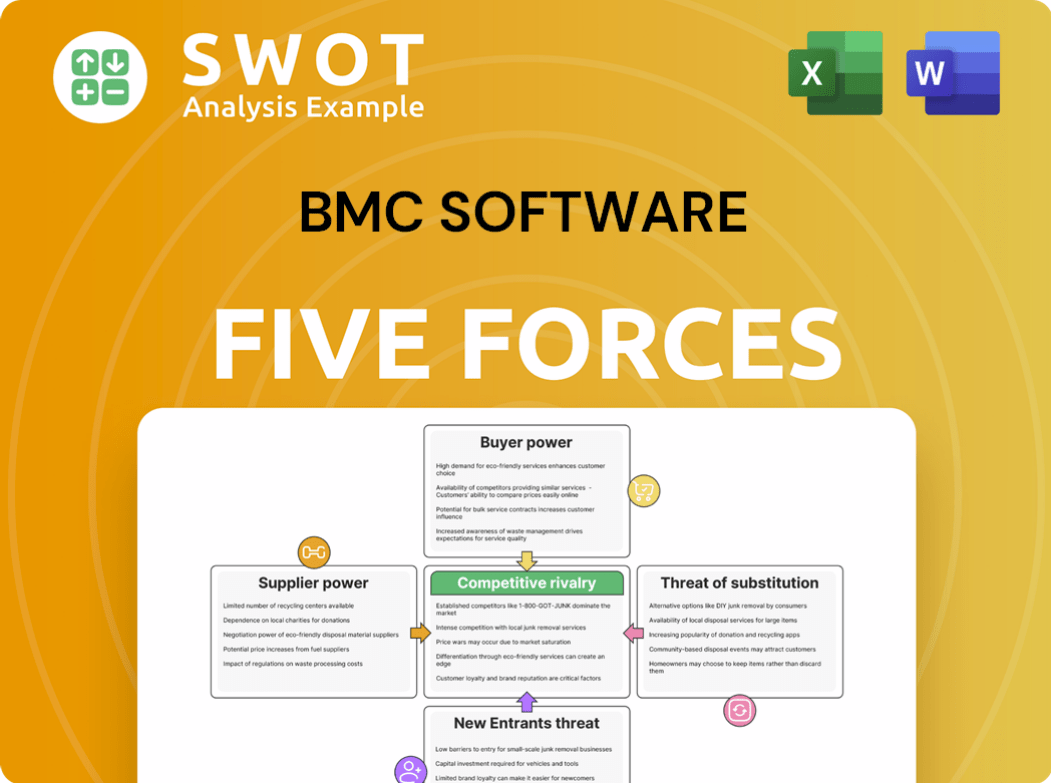
Related Blogs
- What is Competitive Landscape of BMC Software Company?
- What is Growth Strategy and Future Prospects of BMC Software Company?
- How Does BMC Software Company Work?
- What is Sales and Marketing Strategy of BMC Software Company?
- What is Brief History of BMC Software Company?
- Who Owns BMC Software Company?
- What is Customer Demographics and Target Market of BMC Software Company?
Disclaimer
All information, articles, and product details provided on this website are for general informational and educational purposes only. We do not claim any ownership over, nor do we intend to infringe upon, any trademarks, copyrights, logos, brand names, or other intellectual property mentioned or depicted on this site. Such intellectual property remains the property of its respective owners, and any references here are made solely for identification or informational purposes, without implying any affiliation, endorsement, or partnership.
We make no representations or warranties, express or implied, regarding the accuracy, completeness, or suitability of any content or products presented. Nothing on this website should be construed as legal, tax, investment, financial, medical, or other professional advice. In addition, no part of this site—including articles or product references—constitutes a solicitation, recommendation, endorsement, advertisement, or offer to buy or sell any securities, franchises, or other financial instruments, particularly in jurisdictions where such activity would be unlawful.
All content is of a general nature and may not address the specific circumstances of any individual or entity. It is not a substitute for professional advice or services. Any actions you take based on the information provided here are strictly at your own risk. You accept full responsibility for any decisions or outcomes arising from your use of this website and agree to release us from any liability in connection with your use of, or reliance upon, the content or products found herein.